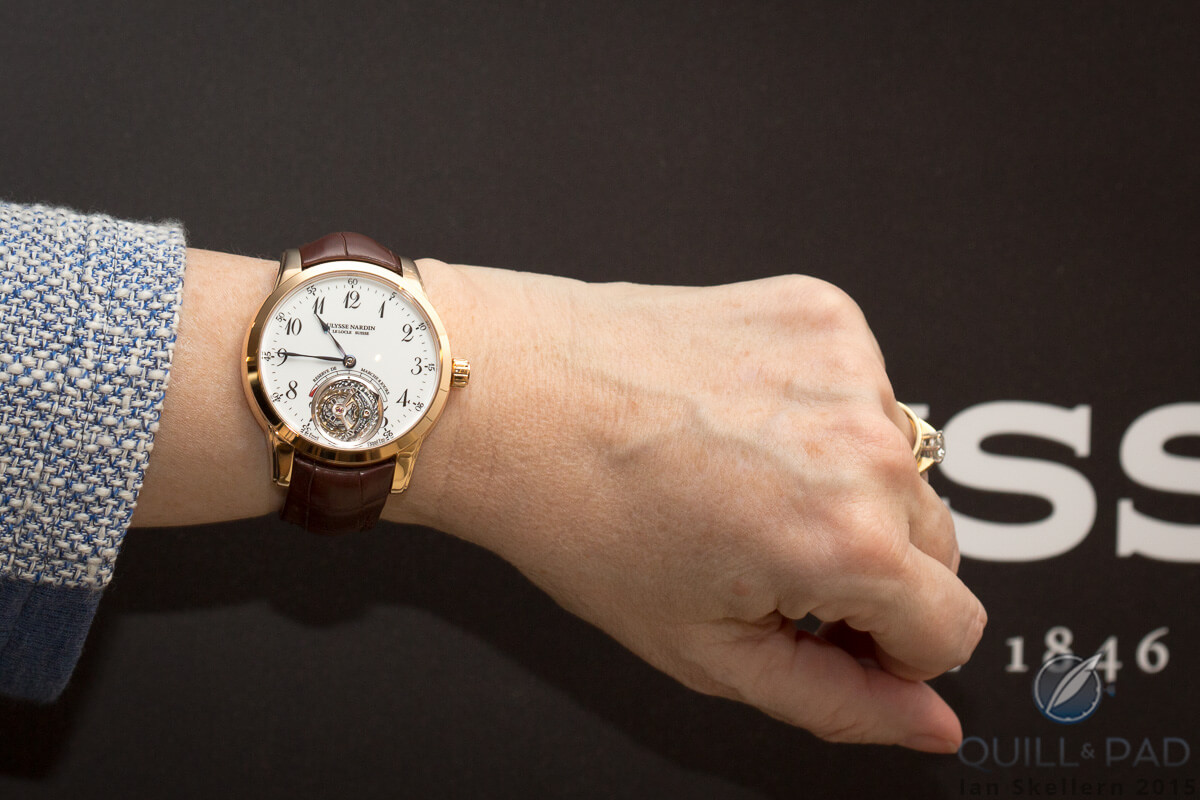Yet again, Ulysse Nardin has come up with something that breaks with traditional horological practice, but at the same time advances it. In the modern era, this has been a role that Ulysse Nardin has largely fulfilled: catalyst, pioneer, risk-taker.
At Baselworld 2014, the Le Locle-based brand did something unprecedented in the world of watches: as its main fair introduction, it introduced a mechanism that the brand had been developing for eight years. Not a watch and not even a whole movement. A mechanism. An escapement (albeit fitted to a test movement in a watch). For more on that, please read Anchors Away: Ulysse Nardin Makes The Anchor Escapement Viable For The Wristwatch.
So it was to be expected at Baselworld 2015 that Ulysse Nardin would introduce the Ulysse Anchor Escapement in a production watch.
And with the new Ulysse Nardin Anchor Tourbillon, the brand did not disappoint.
Caliber 178
The Ulysse Anchor Escapement is now integrated into new Caliber UN-178, whose visuals may remind ardent followers of this brand of the Manufacture Skeleton’s Caliber UN-170, which was introduced at Baselworld 2013.
The visuals and layout of both Caliber 170 and new Caliber 178 were inspired by a 1922 Ulysse Nardin pocket watch movement by James Pellaton (for more information on Caliber 170, see 5 In-House Calibers From Ulysse Nardin).
Naturally, the absolute focus of the movement – and, indeed, the whole watch – is the beautiful escapement positioned at 6 o’clock. The anchor escapement was originally invented a few hundred years ago to further improve isochronism (the ability to run at a constantly good rate) at a time when clocks were anything but reliable.
However, the anchor escapement was deemed unsuitable for use in portable timepieces . . . unsuitable, that is, until the advent of the Ulysse Anchor Escapement.
Thanks to the flexibility of DRIE-etched silicon – a material that Ulysse Nardin has practically pioneered in the modern era – the brand has been able to create the proper geometry to recreate the kinetic motions of a pivot.
As compared to the version of the escapement shown at Baselworld 2014, the final incarnation of the Ulysse Anchor Escapement now contains a redesigned pallet fork. But it also possesses something that kicks the entirety of the construct up an unbelievable notch: low mass, as the final version sees the Ulysse Anchor Escapement housed within a 60-second tourbillon whose carriage contains a full 35 components weighing a mere 0.4 grams.
Caliber 178 beats slowly at a vintage frequency of 18,000 vph (2.5 Hz). While high frequency is usually the order of the day for such progressive, silicon-outfitted movements, this nod to days gone by has a charm all its own. Additionally, the slower beating allows the observer to better see the components at work.
And there’s no need for ultra-high frequency to quell the quest for attaining more precision; the Anchor Escapement boasts constant amplitude. Precision is guaranteed.
The movement also boasts a minimum of seven days’ worth of power reserve thanks to twin mainspring barrels; a power reserve indicator just above the tourbillon cutaway at 6 o’clock depicts the current state of the energy left in the two mainsprings. But make absolutely no mistake: the silicon escapement performing its whirling one-minute revolutions is the star of this show.
Enamel beauty
Despite the integral cutting-edge quality of the movement – and in great contrast to the other impossibly progressive timepiece by this brand, the Freak – the Ulysse Anchor Escapement is clothed in absolutely traditional dress highly reminiscent of the look of a marine chronometer.
Manufacturing the classic-looking dial utilizing an entirely traditional enamel process guarantees this look. Ulysse Nardin-owned dial maker Donzé Cadrans creates its grand feu enamel dials in just the same way they were made in the 1800s. (See Why Do Ulysse Nardin’s Dials Look So Good? Because Donzé Cadrans Authentically Fires Enamel for much more information on this process.)
Housed in an 18-karat gold case from the Classico line, the Ulysse Nardin Anchor Tourbillon is limited to just 36 pieces total. Deliveries are scheduled from May 2015.
Quick Facts
Case: 44 mm, pink gold or white gold
Movement: Caliber UN-178 with one-minute tourbillon and silicon anchor escapement; twin spring barrels guarantee at least 7 days’ power reserve
Functions: hours, minutes; power reserve indication
Limitation: 18 pieces each in rose gold and white gold
Price: 88,400 Swiss francs (white gold); 84,000 Swiss francs (pink gold)
Trackbacks & Pingbacks
-
[…] The culmination of this joint venture was the Ulysse Anchor Escapement of 2015, a timepiece proving that the historical anchor escapement could be made viable for wristwatches thanks to new technologies. For full details on this watch, see The Ulysse Anchor Tourbillon By Ulysse Nardin. […]
-
[…] For more on the Ulysse Nardin Ulysse Anchor Tourbillon, please see The Ulysse Anchor Tourbillon By Ulysse Nardin. […]
Leave a Reply
Want to join the discussion?Feel free to contribute!




























































I fail to see the innovation here, this is a lever escarpment with modified geometry. An anchor escapement can only exists with a pendulum and recoil.
Precisely the point: an anchor escapement has really only existed in clocks up to now. It’s much easier to see the escapement components and I also go into the technical aspects of it more deeply in this post: http://quillandpad.com/2014/04/15/anchors-away-ulysse-nardin-makes-the-anchor-escapement-viable-for-the-wristwatch/
I liked this watch a lot at Baselworld, one of the very refreshing pieces at the fair. And aside from the Date version of the Freak, this was the coolest piece of Ulysse Nardin this year. It is also very wearable.
really should be showing a video of the movement, like this https://www.youtube.com/watch?v=RtdbBUsaa40